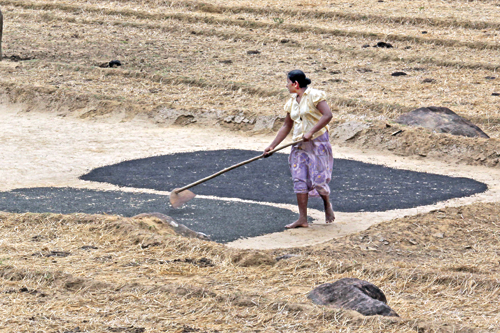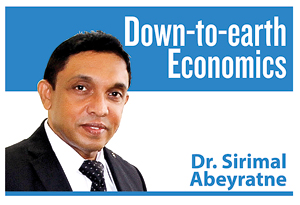Tale of two educated villagers
View(s):
Young people are moving to other jobs, away from continuing the tradition of their parents as farmers.
Senevirathna and Piyarathna are the sons of Ukku Banda who came with his family to the North Central Province after receiving a few acres of agricultural land from the government. The village they resided, which was called “Padikaramaduwa”, was created under the Huruluwewa colonisation scheme in the 1950s.
Calendar from Colombo
Ukku Banda planted his entire land with coconut, leaving some parts for paddy and vegetables. He would send his tomato harvest every week to a vegetable trader in Pettah, Colombo. Unlike nowadays, Ukku Banda would wrap each tomato fruit in tissue paper and, carefully pack them in wooden boxes in preparing for transportation to Colombo. At the beginning of every New Year, he receives a complimentary calendar by post from his vegetable trader, which is left for him by the postman at the village boutique.
Ukku Banda and his wife were engaged tirelessly in cultivating their entire land by getting water from Huruluwewa. Unlike many other villagers in the neighbourhood, he didn’t want to disrupt schooling of his sons and to get their support for farming; rather he encouraged them to continue with their school education. Later, Ukku Banda died leaving his two children along with the mother.
In the 1960s, both Senevirathna and Piyarathna sat for the Senior School Certificate (SSC) examinations, which was replaced later with the GCE Ordinary Level. They both passed the SSC and, became the first and the second from the entire village to pass it. Those days it was not common to find educated people so that having the SSC qualification was not normal. And having it by two village boys from a remote colony in the dry zone was also extraordinary. According to the Central Bank’s Consumer Finance Survey of 1963, while over a quarter of people in the country had ‘no schooling’ at all, only 22.7 percent of the people had passed secondary level education.
The family with two educated children was regarded with high esteem by the neighbours and the relatives. For the same reason, some of their relative families also sent their children to stay at their home in the company of Senevirathna and Piyarathna and to go to the same school. Two such children from relative families were Lal and Sugath, who also passed the SSC exams well.
Government jobs
Senevirathna and Piyarathna then began preparing for government jobs. Private sector jobs were uncommon those days, while the private sector expansion had been curtailed by government policies. From time to time, villagers saw Senevirathna and Piyarathna dressed in white national suit walking across the village to the main road in order to get a bus; they were going for job interviews. They carried out this journey many times a year and many years from the 1960s to the 1970s.
In between job interviews, both Senevirathna and Piyarathna had nothing to do at home; they slept throughout the day. Whenever a neighbour or a relative visited their home, they often found both of them sleeping even if it was daytime. Only their mother was seen working in the land and cooking meals at home.
 They never got any government job, and they became over-aged for any new job after seeking jobs for more than 10 years. Both of them got married, however, and had children too. The land was also divided between the two brothers. Their family life too was not strong enough to have a major breakthrough in their sleeping habit. Senevirathna’s wife visited the village only once, didn’t stay too long and went back to her own home. As she never returned again, Senevirathna had to visit her once in a while.
They never got any government job, and they became over-aged for any new job after seeking jobs for more than 10 years. Both of them got married, however, and had children too. The land was also divided between the two brothers. Their family life too was not strong enough to have a major breakthrough in their sleeping habit. Senevirathna’s wife visited the village only once, didn’t stay too long and went back to her own home. As she never returned again, Senevirathna had to visit her once in a while.
Senevirathna, the elder of the two, is now in the late-70s and, still living all alone in his home. Younger brother, Piyarathna died recently from a head injury; the injury was caused by a log that fell on the head from the dilapidated roof of his house. The two children of the relative families who came to stay and study there – Lal and Sugath also never got jobs. Later the villagers heard the news that both had died after joining the second JVP insurrection in the 1980s.
Buried stories
The above – a true story -, was one of the many stories that have got buried in our economic history. In fact, while each person of our older generations has a story of his or her own, I believe a significant number of them were about loss of hopes and disappointments. It would be good if we have the opportunity to dig into them – at least a couple of them, to understand their loss of hopes in the context and to reveal our economic reality at the time. It’s not because we enjoy digging into buried stories, but because it would be helpful in preparing our path to the future.
I don’t deny the fact that everyone is unlikely to be equally competitive so that there are candidates who don’t succeed at the interviews. Leaving room for some degree of reservations on the part of the candidates, it’s my attempt to reveal the other side of the coin – the economic reality explaining the lack of opportunities for many over many years as in the case of both Senevirathna and Piyarathna.
Let me first elaborate the demand side of the opportunities: It was a time of a disproportionately large increase in youth population, nurtured well in a newly established free health and free education system of the country. The population growth was as large as 2 – 3 percent per annum due to what was called “modern death rate combined with primitive birth rate”. As of 1963 estimates, more than half of the people in the country was less than 18 years of age.
Shrinking opportunities
The problem was, however, on the part of “creating opportunities” to meet the aspirations of healthy and educated youth. In the quest for upward social mobility, they wished to leave their parents’ traditional socioeconomic background for “new opportunities” in a modern environment. But the problem was that economic policies that were needed to create such opportunities were in the opposite directions so that the opportunities were actually shrinking.
By 1973, the unemployment rate was 24 percent, while the majority of the unemployed were the “educated youth” who had secondary or post-secondary education and in the age group of below 25 years.
The government thought of doing almost everything “economic” so that the policies and regulations were created in favour of the government and against private business since the late 1950s, deepened in the 1960s and, worsened in the 1970s. Private sector expansion was paralyzed with the initiation of the “nationalisation” programme, tightening import controls and, the regulations constraining private business; hence, there was no supply of jobs from the private sector. Today we lament saying that “there is no capitalist class in Sri Lanka” which is a result of killing the emerging capitalist class in the post-independent history.
By the way, when there is anything short of supply, its perceived value is on the rise; therefore, the “value” of jobs rose rapidly and, it became even more valuable for politics. Thus, giving away scarce government jobs was taken over by the politicians, on a small scale in the 1960s and large scale in the 1970s, while it was never given up even after 1977. Apart from the shortage of jobs, another reason why Senevirathna and Piyarathna or Lal and Sugath never received jobs, was that they did not have the required political affiliation!
Any lessons?
We have the bitter experience of twin-wars triggered by the frustration of “educated youth” in the South which emerged twice in 1971 and in 1987 as well as in the North which lasted for 30 years! Our policies and politics have played a major role in both. The question remains, have we learnt any lesson from our catastrophic history?
(The writer is a Professor of Economics at the University of Colombo and can be reached at sirimal@econ.cmb.ac.lk and follow on Twitter @SirimalAshoka).


